2001: A Space Odyssy - Arthur C. Clarke Memorial Game
In Memory
Arthur C. Clarke (1917 - 2008)
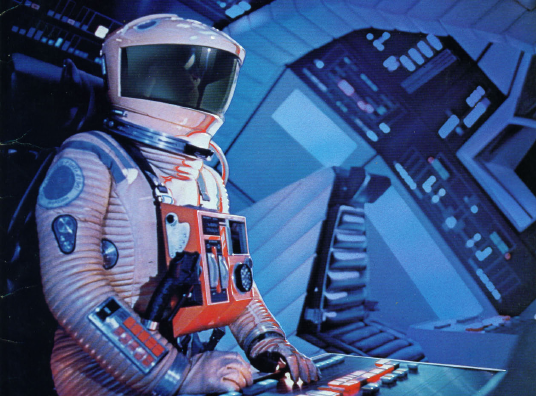
Discovery Deck Plans
U.S.S. DISCOVERY
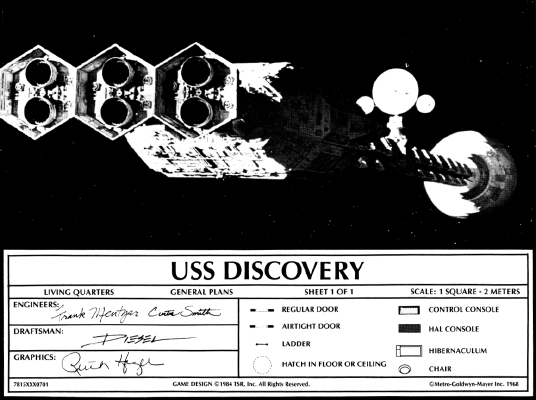
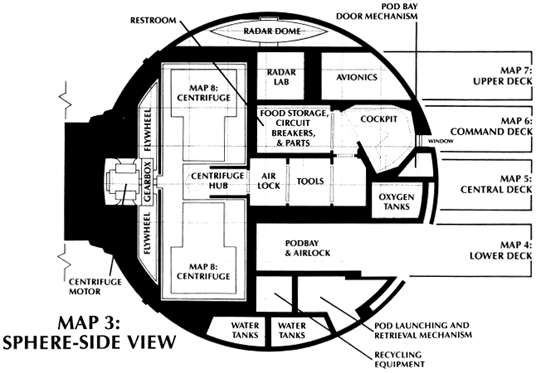
DOORS
The DISCOVERY has two kinds of doors: regular and airtight. All doors open and close by sliding into and out of the wall next to the doorway.
A regular door has 20 structural points. It is not airtight. A latch can be opened from either side of the door holds a regular door shut.
An airtight door is primarily a safety devices on spaceships. An airtight door has 75 structural points. When an airtight door is shut, it automatically seals.
Normally, an airtight door opens electronically when a button on the door is pressed. Characters can switch individual airtight doors to manual, if desired. The ship's computer can control all airtight doors except those switched to manual. When there is no power to an airtight door, it must be opened and closed manually.
All airtight doors on the Discovery have pressure locks (level 2). These locks prevent the doors from opening when the pressure on both sides of the door is different by more than 10%. Thus, a door between a pressurized room and a depressurized room cannot open until both rooms are brought to the same pressure. However, a character can override a door's pressure lock by flipping a switch on the door. Gauges on the wall next to each side of the door show the pressures on both sides of the door.
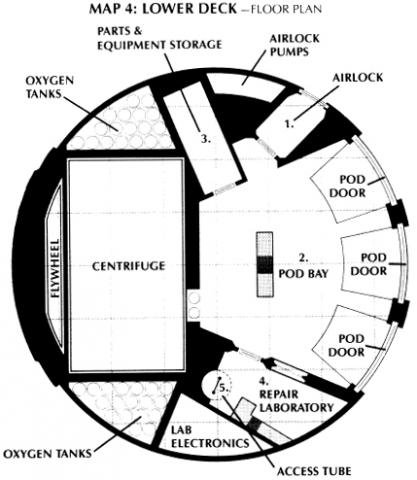
LOWER DECK
1. AIRLOCK
There are no implements in this room. It is cubical in shape with rounded edges on all sides. There are airtight doors on both sides of the airlock
2. POD BAY
The door between the airlock and the pod bay is normally closed.
3. PARTS & EQUIPMENT STORAGE
Cabinets and lockers cover all sides of the room. These lockers contain spare parts for all the equipment on the ship except HAL, the cockpit, and the circuit breaker room. Equipment for repairing Discovery's exterior is also stored here.
4. REPAIR LAB
This room connects directly to the access tube (area 5).
This lab is used to test and repair portable equipment, and to prepare samples for further analysis in the science lab (area 7). The air pumps, launching platforms, and pod bay doors can also be controlled from here.
5. ACCESS TUBE
This circular tunnel connects all decks on the ship, except the centrifuge. It starts in area 4 on the pod bay deck, leads to area 6 on the central deck, then leads to area 18 on the command deck, and finally ends at area 22 on the upper deck. A ladder runs up the center of the tunnel.
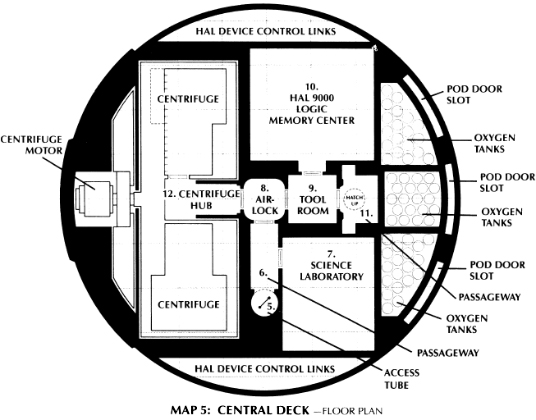
CENTRAL DECK
6. PASSAGEWAY
The access tube (area 5) opens directly into this hall. At the port end of the hall, an air-tight door leads into the airlock. A regular door in the forward side of the hall leads into the science laboratory.
7. SCIENCE LABORATORY
The ceiling and walls of the laboratory are covered with cabinets. They contain glass test tubes and flasks.
This laboratory is used to analyze samples and instrument readings. Here, the astronauts can perform chemical and electrical experiments. They can also construct electrical devices and prepare chemicals in this lab. (Chemicals are stored in area 21.) There is a HAL terminal here.
8. AIRLOCK
There are no implements in this room. It is cubical in shape with rounded edges on all sides. There are airtight doors on both sides of the airlock.
9. TOOL ROOM
The walls, ceiling, and floor are covered with tools in clamps and straps. All the tools needed to test and repair the interior of the Discovery are stored here.
10. HAL LOGIC MEMORY CENTER
The elliptical airtight door to this room has three signs on it, reading:
"No Admittance Except To Authorized Personnel"
"Have You Obtained Certificate H.19?"
"Ultra-clean Area - Suction Suits Must Be Worn."
The ship cannot be controlled from here, except by HAL. This room is only a repair access to HAL's memory and central processing unit.
11. PASSAGEWAY
There is a closed circular hatch in the ceiling of this room. A large fire extinguisher stands in a niche in each side wall. Conduits and cables line the walls in several places.
12. THE HUB
This is a circular passageway. A door at the aft end leads to the centrifuge. When the centrifuge is spinning, the aft part of the hub revolves with the centrifuge.

COMMAND DECK
13. COCKPIT
The cockpit walls are covered with knobs and buttons, surrounded with indicator lights. A view of the area forward of the Discovery is visible through the windows.
If HAL is not controlling the Discovery, the astronauts can fly the ship from the cockpit.
From here, characters can monitor and control all the ship's functions, including life support, and the atomic engine. There are two HAL terminals here.
14. PASSAGEWAY
This is one of the main passageways in the Discover; it connects areas 11, 13, 15, 16, 17, and 18.
15. SPARE PARTS CLOSET
All spare parts for HAL, the cockpit, and the circuit breaker room are stored here. A few simple tools to make the replacements are kept here as well.
16. WATER CLOSET
This toilet contains several water pipes.
17.CIRCUIT BREAKER ROOM
The walls of this room are covered with hundreds of small black circuit breakers. The circuit breakers are "on/off" power switches for everything in the ship. At the end of each row of breakers is a large yellow switch. Above all the switches are these large red switches, each covered with a clear plastic case.
The yellow switches are the system circuit breakers; each controls a room or small portion of the ship. The red switches are the master circuit breakers. One controls power to the entire sphere, and the last one controls power from the auxiliary power from the power generators. All the switches are in the "on" position.
If a character makes repairs, he must switch the appropriate circuit breakers off, and then on again.
A fire extinguisher hangs on the wall near the door. An airtight hatch in the ceiling leads to the life support center, area 24.
18. PASSAGEWAY
The hallway leads from the access tube into the freezers and hallway 14.
19 & 20. FOOD FREEZERS
These rooms are used to store perishable food. The food freezers' doors are not airtight, but they are heavier than the regular doors on the Discovery. The temperature gauges on the doors read -15 degrees centigrade.
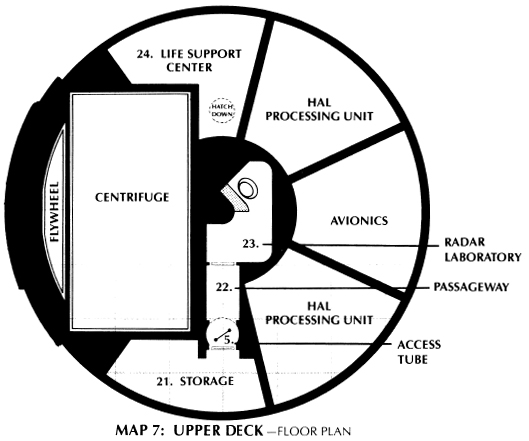
UPPER DECK
21. STORAGE
This area holds dry chemicals and the crew's personal belongings. Cabinets cover all the surfaces of the room. Racks suspended on guy wires form a riow down the center for yet more storage.
22. PASSAGEWAY
This dim, barren hallway connects the access tube with the radar laboratory, area 23.
23. RADAR LABORATORY
This lab holds all of the exterior sensing equipment of the Discovery. There are telescopes, Doppler scanners, energy sensors, spectrometers, radar dishes, and radio telescopes in this room. Through HAL, the astronauts can control and monitor all the equipment here from anywhere on the ship. There is HAL terminal here.
Some of the equipment above the radar lab swivels on ball bearings, which require occasional lubrication.
24. LIFE SUPPORT CENTER
The airtight hatch to this room is in the floor.
The life support system maintains the air pressure, oxygen mixture, and temperature, and recycles all water and most waste material.
The life support system is normally controlled by HAL. Characters can also control it manually from consoles in the cockpit and centrifuge. This room is used to inspect and repair the life support system. There is a HAL terminal here.

CENTRIFUGE
25. CENTRIFUGE
The centrifuge spins to simulate normal gravity. It is usually at rest, rotated during exercise and meal periods. HAL turns it on and off when asked; it can also be controlled manually from station E, H, or L (see below).
The door in the hub opens easily. From the door, a ladder leads down to the floor of the centrifuge. (In zero gravity the ladder is not needed.)
- William Hunter, in his hibernaculum.
- Peter Whitehead, in his hibernaculum.
- Victor Kaminski, in his hibernaculum.
- Main hibernaculum controls, including the Master Hibernation Timer. All five hibernaculums are monitored here. HAL normally controls the operation of the hibernaculums. A character may control them manually if HAL releases control, or if HAL's Security can be defeated or bypassed. A -20% penalty applies to all such attempts.
- Medical and relaxation table. There is a HAL terminal in the wall here.
- Frank Poole's bed and empty hibernaculum.
- David Bowman's bed and empty hibernaculum.
- Lounge and dining table. A HAL terminal is inset in the table top.
- Science station. From here, a scientist can monitor and control experiments in all the labs. This station can also control most of the equipment I the radar lab.
- Atomic Engine Control. The engine reactor is monitored and controlled from here. Some repairs to the atomic engines itself can be carried out from here.
- Food processor. Processed food is dispensed from slots in the wall here, and served on trays. The food looks, smells, and tastes like normal food, but most of it is actually processed soymeal.
- Flight controls. From here bowman and Poole monitor and control the navigation and flight of the ship. All the functions of the cockpit are duplicated here. These controls cannot override HAL, but the controls in the cockpit can. There are two HAL terminals here.
- Surveillance and detection station. From here, the crew can study and observe space and objects around the ship. This station controls all the equipment in the radar laboratory. Some of these controls are duplicated at the science station (I).
- Communications station. The large antenna in the middle of the ship is controlled here. All messages are sent and received either here or in the cockpit.
- Flywheel. The flywheel is a very heavy steel rim connected to a shaft by large flat spokes. When the centrifuge spins, the flywheel spins in the opposite direction to stabilize the ship.
Robots
There are several robots on the ship that cater to the crew's every need. All but the Anthropomorphic Service Robot are controlled by HAL. These are:2 Maintenance Robots
3 Service Robots
1 Medical Robot
3 Workpods
1 Anthropomorphic Service Robot